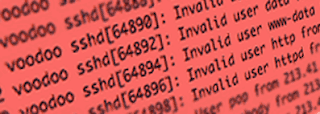
If you run any Unix-like systems, you probably know that the bad guys are trying to break into your server over SSH. You can use fail2ban or sshguard to greatly reduce the chances of a break-in. Below, I show how I setup sshguard on my FreeBSD servers. Its quick and relatively easy, so I consider it a requirement for all of my FreeBSD servers.
First, install sshguard from the ports collection:
cd /usr/ports/security/sshguard
make install
Next, tell FreeBSD to allow it to start by adding this line to /etc/rc.conf:
sshguard_enable="YES"
Then start it and stop it. This will create a configuration file that we'll use.
service sshguard start
service sshguard stop
Now the file /usr/local/etc/sshguard.whitelist should exist. Edit that and add any IP addresses that you might need to whitelist. For example, I whitelisted my network monitor. My reasoning was that it would test if the SSH service was still running every 60 seconds. So this would look like a break-in attempt and the monitor would be blocked after a few minutes.
You might also wish to whitelist certain other hosts, but I don't recommend whitelisting everything in your internal network. If someone did manage to break into your web server or some other system, they could then use "island hopping" to get to this host and break into it, too. So sshguard makes that harder on the attacker.
To add items to the whitelist, just add one IP address or FQDN per line. If you want to insert a comment, you can start the line with a "#" and then write your comment. I highly recommend putting a comment just above every entry. A few years from now, after an IP address is assigned to a different server, you might not remember why it is in your whitelist. Comments can help your future self save time.
Now just start the service back up with this:
service sshguard start
To confirm that it's running, try this:
service sshguard status
That is all it takes. If sshguard sees a suspicious attempt to login, it will add the IP address to the top of /etc/hosts.allow as a "deny" rule. It will take care of things all by itself from now on.
If you find that it blocked an IP by mistake, you can remove the block by just removing its IP from the hosts.allow file. Just be sure that you can really trust that IP. Maybe someone put a rootkit or bot on that host and sshguard is doing exactly what it should be doing. So be confident that its an error before removing the IP.
A few last notes: First, sshguard will log some data in /var/db/sshguard/blacklist.db. As far as I can tell, this is more or less just a log. I think sshguard uses it at startup time, but I'm not sure. If you need to remove the blacklisting from an IP, edit /etc/hosts.allow instead.
Second, there are a few different ways to setup sshguard. One of them involves piping data from syslog into sshguard. Others involve using PF or IPFW instead of hosts.allow. I haven't used those option and don't know the relative advantages and disadvantages of each method. What I've presented here is what works for me. Please feel free to research the options further and do what works for you. If you know why I should consider another method, please leave a comment on this article. I would truly appreciate the advice.
Lastly, don't forget that this is looking for persistent failed logins from a single IP. Advanced Persistent Threats can use botnets to try out one or two passwords from an IP and then one or two from another IP and so on. Patient attackers might also try one or two passwords every few hours until they guess right. People who know you or looked at the password list you keep under your keyboard are much less likely to be stopped by sshguard. The bottom line is simple: sshguard helps reduce risk but security is a mindset and not something any single product can give you. Be smart and be safe out there.
No comments:
Post a Comment